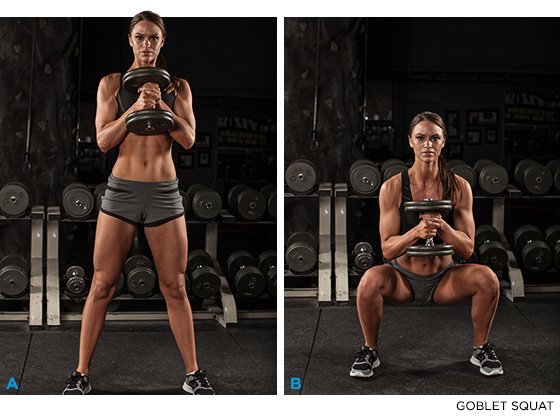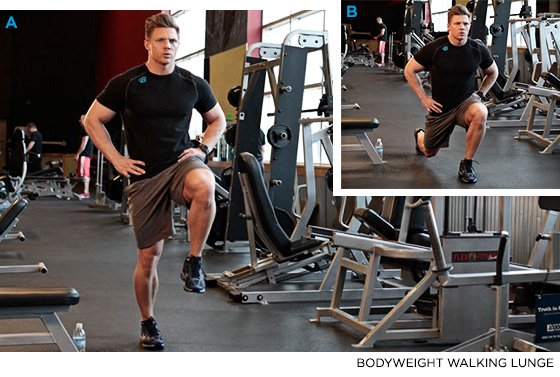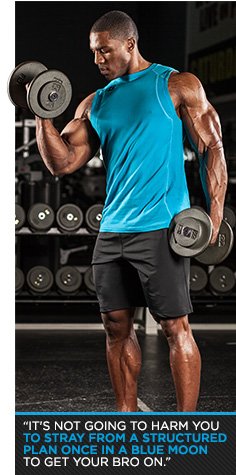Hotel gyms can be depressing, but your program doesn't have to suffer. With a little imagination and planning, your time on the road can leave you better off than when you left home!
If you're one of my fellow Frequent Flyer Club members, you know how difficult it can be to stay on a regular training schedule. With limited access to quality gyms, an agenda of back-to-back-to-back meetings, and the ever-constant pull to cozy up in your freshly made bed and watchFriends reruns in the evening, fitness quickly moves down the priority list.
If hotel gyms were 6,000-foot elite training facilities, this wouldn't be the case. As it is, their dumbbells top out at 50 pounds—if you're lucky—and the exercise equipment is usually limited to the creaky ol' treadmill, a half-inflated Swiss ball, and a laughable ab device of indeterminate origin.
The easiest option is wing it and try to be satisfied with a half-decent improvised workout. Wait, scratch that: The easiest option is to forego training altogether and order room service. Of course, you could also always revert to sweating away on whatever cardio machine is available, but for some of us, that's not the same thing as "training."
If that sounds like you, it's time to get creative. Here are five workout options you can take on the road with you to get your strength training fix. If you still need to collapse in a puddle of sweat after these, throw in some metabolic conditioning circuit or intervals on the treadmill afterward.
Now that all your excuses have been smashed, what are you waiting for?
Option 1 /// Resistance Bands
Take it from me: Invest in a few pair of resistance bands, and guard them with your life. They take up virtually no space, and their uses are limitless.

Bands usually come in one of two styles: a single length of tubing with some type of handles on both end, or a closed loop. They're usually color-coded, and especially when it comes to the loop variety, the strength of a band will be dictated by its thickness. Many people start with either one band or a pair, but once you figure out all the exercises you can do with them, don't be surprised if you start to develop a collection.
The bands are great for mobility movements like X-band walks and band pull-aparts, but they're also solid as a substitution for loaded exercises. The band squat-and-press (particularly with a band with handles), Pallof press, and face pull are three simple movements that work perfectly with bands. Put them together, and you have most of a full-body workout.
If you're the go-heavy-or-go-home type, well, too bad, because you can't go home; you're in a hotel. But you can still use a band to increase the external resistance for loaded exercises. Wrap them around your dumbbell and anchor the end of the band to the ground with the bench, then dumbbell bench press yourself silly.
The resistance increases as you push weight to the top of the movement, which will force you to be more explosive and help you with your lockout. With a little help from YouTube, you can put together a similar setup for just about any compound exercise.
Option 2 /// Eccentric Training
Try this: Grab a 30-pound dumbbell and perform 10 regular reps of ass-to-grass goblet squats. Take a 1-minute break. Then do it again, this time with a 3-second count on the way down, and explode on the way back up. Feels a little bit harder, huh?
Slowing down the eccentric (or muscle-lengthening, such as in the lowering half of a squat) portion of a movement has been proven to lead to a greater increase in strength gains as compared to simple concentric (or muscle-contracting) training. The muscle fibers experience greater neural adaptation and undergo more stress.

Experiment with a variety of exercises for eccentric training. Think about lowering slowly on your chin-ups, calf raises, bench press, and even biceps curls. The difference you feel may surprise you.
I'm not saying we should be stuck in slow motion all the time or do Tai Chi with weights. I'm suggesting you practice better control of the weight, rather than bouncing the barbell up and down as we are wont to do. I get it: It's fun to say you can curl 135 pounds, even if you have to throw your whole body into the movement to do it. But having access to that much weight can also lead you to neglect an important element of your training.
You're on the road and away from the gym. Nobody is watching or taking note of the number in your hand. This is a chance for you to use your time away from the gym in a way that will make you better overall.
Option 3 /// Unilateral Training
Back squats, conventional deadlifts, bench presses, and bent-over rows. What do they have in common as most people perform them? A seven-foot-long bar of metal that you can't bring on an airplane, and you won't find in almost any hotel gym.
Enter unilateral training. Instead of back squats, stick with single-leg quad-dominant movements: lunges, Bulgarian split squats, and step-ups. In lieu of barbell deadlifts, you can swing with the single-leg deadlift. And don't come crying to me when it's hard to walk all the way to the free continental breakfast in the morning.

OK, that all sounds good, but what's the point besides making you feel like less of a badass?
Unilateral movements reveal imbalances. In the gym, it's easy to overlook the way your barbell tilts slightly to the right when you're bench pressing. But what it means is that your left side is stronger than your right. This becomes crystal clear when you switch to dumbbells and find yourself squeaking out two fewer reps on one side than the other.
This isn't insurmountable. The solution is just to take it into account in your programming. Always start with your weak side first, and then match the number of reps on your strong side. Continue this for long enough, and you'll find the strength discrepancy minimizes.
Unilateral training works the core and stabilizer muscles. What do you do when you're lying on your back while pressing a 50-pound dumbbell in one hand? You squeeze your glutes and brace your core to keep your body from tilting over to the side. You don't have a choice! Now try performing a reverse lunge. You'll notice it requires a lot more coordination (via recruitment of the adductors and abductors, to name a few) than a regular squat.
Single-limb training carries over to everyday life. Many of our daily actions require movement from one leg or one arm. Reaching for a jar of peanut butter—or a dumbbell, for that matter? One arm at a time. Walking up and down the stairs? Bunny hop at your own risk; the rest of us are stepping. Better coordination of unilateral movements will help you move fluidly and prevent injury in the gym and out.
Option 4 /// "Just Because" Day

Riddle me this: If a lifter curls in the squat rack, and no one is around to see it, did it really happen?
Sure, a structured day of squats, deadlifts, and rows is fun, but do you know what else is fun? Being on vacation. Perhaps you've been staying away from preacher curls because you've been dedicating your time to all the big compound movements. Maybe you miss feeling the pump and, like my former co-interns at Cressey Performance, you dig the idea of having an "arm farm" day.
Just like watching a little bit of mindless television every now and then doesn't hurt, it's not going to harm you to stray from a structured plan once in a blue moon to get your bro on. What happens in the hotel gym stays there, so curl to your heart's content, or spend some time obsessing over the long head of your triceps. Maybe you could just work on your dumbbell snatch technique, because you're not ready to show it off in your regular gym just yet.
As long as you're being smart about it and not trying to balance one-legged on a Swiss ball with a loaded barbell on your back, have at it. There's nothing like an impromptu day of guilty pleasures to keep your motivation from going stale.
Option 5 /// Mobility Work
Raise your hand if you foam roll and go through a full dynamic warmup before every single training session without fail. That's what I thought.
I don't think I'd be exaggerating to say that the large majority of us likely don't dedicate nearly enough time to our mobility—and I'm not talking about static stretching here. Foam rolling and dynamic stretches are here to stay, and just because they aren't as triumphant as barbell squatting a 4RM doesn't mean you can skip them. Finding yourself stranded in a strange empty gym with a scarcity of equipment is the perfect opportunity to devote a solid half-hour to your tissue health and integrity.

No comments:
Post a Comment